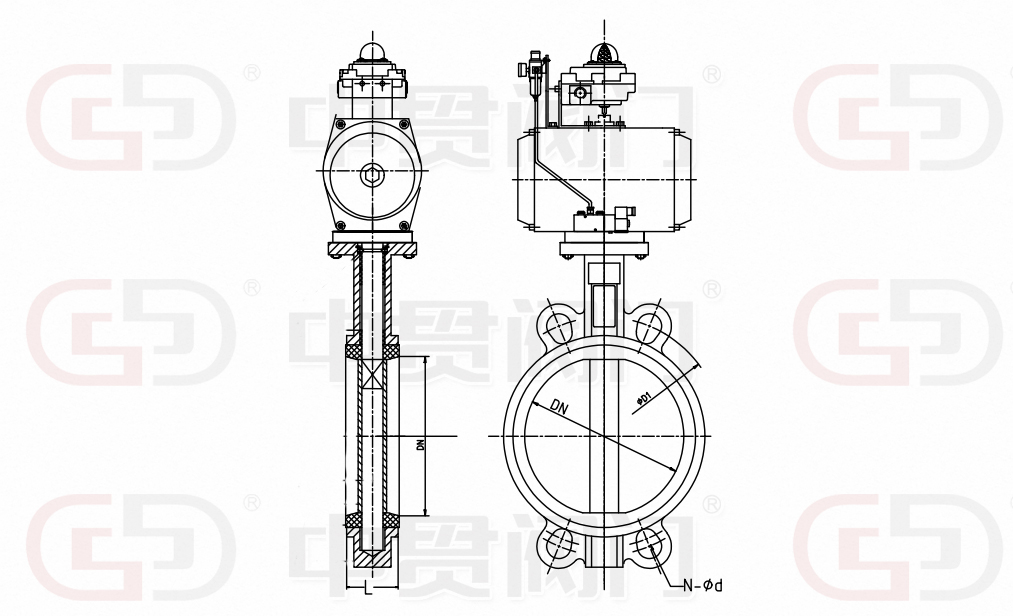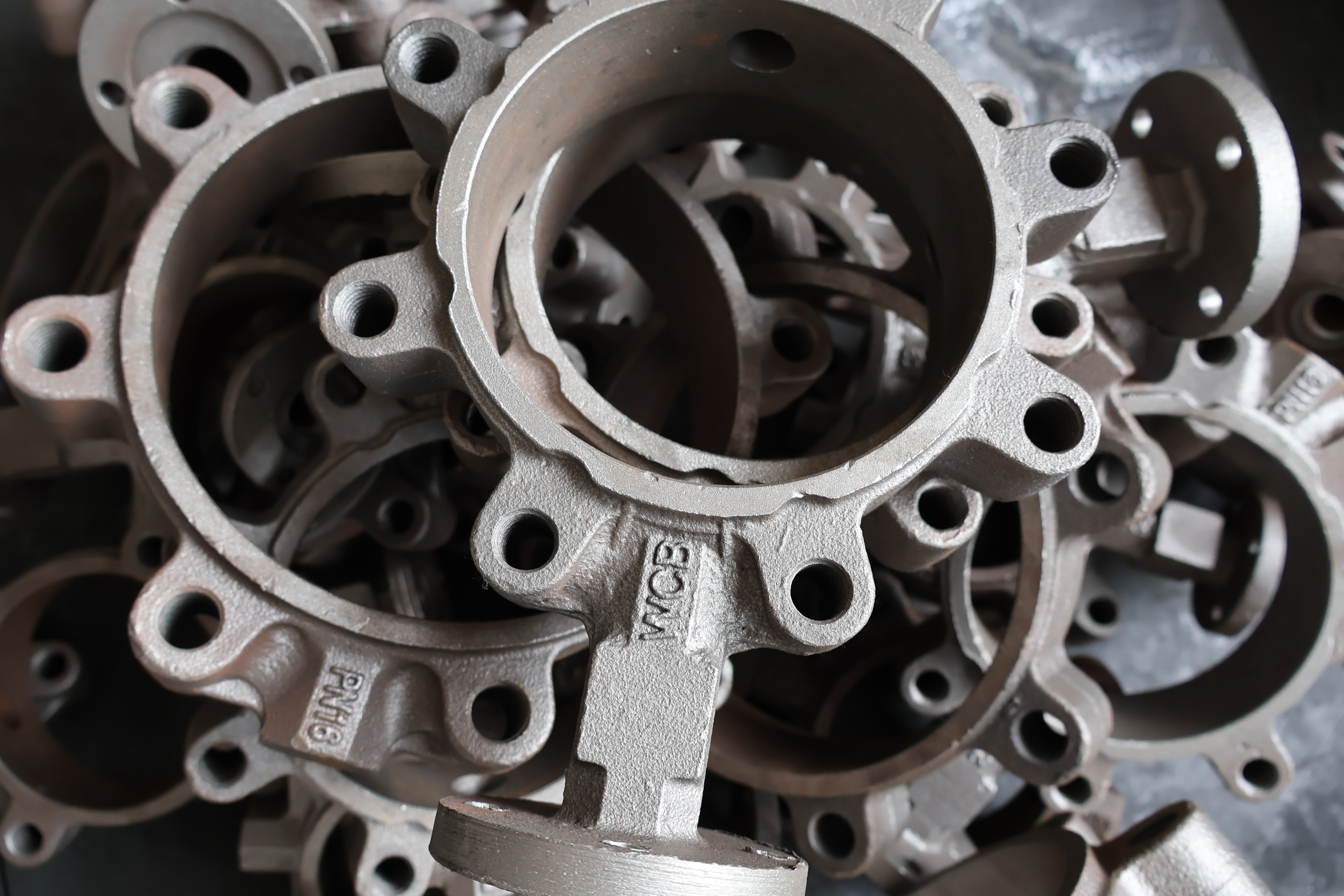An Introduction of Wafer Type Butterfly Valve
The Definition of a Wafer Type butterfly valve
A wafer type butterfly valve is a type of valve that controls the flow of fluid within a piping system. It consists of a disc, which is mounted on a central shaft, allowing it to rotate within the valve body to either fully block or permit the flow of fluid. The wafer design means that the valve is sandwiched between two pipe flanges without the need for additional bolts and nuts, making installation and maintenance easier.

Why is it Called a Wafer Butterfly Valve
The term “wafer” in “wafer butterfly valve” refers to the thin, disc-like shape of the valve and its installation method. The valve’s design is reminiscent of a wafer, which is a thin, crisp cake or biscuit. Similarly, the valve itself is thin and lightweight compared to other types of valves, and it is designed to be sandwiched between two flanges in the piping system without the need for additional bolts and nuts.
Introduction to Components of Wafer Butterfly Valve
- Body: The body of a wafer butterfly valve serves as the primary housing for other components and provides the main structure of the valve. It is typically made of durable materials such as cast iron, ductile iron, carbon steel, or stainless steel. The body is designed to accommodate the disc and stem assembly, as well as to connect to the pipeline through flange connections.
- Disc: The disc, also known as the butterfly, is a crucial component responsible for controlling the flow of fluid within the valve. It is usually disc-shaped and rotates on a central shaft or stem. The disc can be made of various materials, including stainless steel, cast iron, aluminum, or PVC, depending on the application requirements.
- Stem: The stem is a shaft that connects the disc to the actuator or handle outside the valve body. It transmits the rotational motion from the actuator to the disc, allowing for precise control of the flow. The stem is often made of stainless steel or other corrosion-resistant materials to ensure durability and longevity.
- Seat: The seat forms a seal around the perimeter of the disc when the valve is closed, preventing leakage of the fluid. It is typically made of resilient materials such as EPDM, NBR, or PTFE, which can withstand a wide range of temperatures and pressures. The seat may be integral to the valve body or replaceable for easier maintenance.
- Actuator: While not always a standard component, many wafer butterfly valves can be equipped with an actuator for remote or automated operation. The actuator can be pneumatic, electric, hydraulic, or manual, depending on the application requirements. It provides the necessary force to open, close, or modulate the valve according to the control signals received.

(The Drawing of Wafer Type Butterfly Valve with Pneumatic Actuator)
Design characteristics of wafer type butterfly valve
- Thin Profile: Wafer type butterfly valves have a thin profile, making them lightweight and suitable for applications where space is limited.
- Wafer Body: The valve body is designed as a wafer, meaning it is sandwiched between two flanges in the pipeline. This design eliminates the need for additional bolts and nuts, simplifying installation and reducing overall weight.
- Butterfly Disc: The valve features a disc with a butterfly-shaped profile, which rotates on a central shaft to control the flow of fluid. The disc is typically made of metal or a durable polymer.
- Resilient Seat: The valve incorporates a resilient seat, often made of materials such as EPDM or PTFE, which provides a tight seal when the valve is closed and helps prevent leakage.
- Bi-Directional Flow: Wafer type butterfly valves are typically designed to allow flow in both directions, offering versatility in various piping systems.
- Low Pressure Drop: The streamlined design of the butterfly disc minimizes pressure drop across the valve, allowing for efficient fluid flow.
- Manual or Actuated Operation: Wafer type butterfly valves can be operated manually using a handle or lever, or they can be actuated using pneumatic, electric, or hydraulic actuators for remote operation.
- Compact and Economical: These valves are often chosen for their compact design and cost-effectiveness, making them a popular choice for a wide range of applications in industries such as HVAC, water treatment, and general industrial processes.
Differences Between Lug Style and Wafer Style Butterfly Valves
The primary contrast between the two variants lies in their design: wafer valves boast a streamlined build with sealants situated along the edges, whereas lug butterfly valves are more intricate, utilizing bolts and nuts to secure the components. Additional disparities encompass dimensions, robustness, and installation and maintenance requisites. When incorporated into HVAC systems, both offer distinct advantages, underscoring the importance of comprehending each variant before selecting the ideal option for installation.
The main differences between wafer and lug butterfly valves include:
- Design:
Wafer valves have a compact design with sealants placed at the edges, while lug butterfly valves are more complex, utilizing bolts and nuts to secure the valve between flanges.
- Installation:
Wafer valves are installed between two flanges without the need for additional bolts and nuts, whereas lug butterfly valves require bolts and nuts to be fastened to the flanges on both sides.
- Size and Strength:
Wafer valves are generally lighter and more compact, suitable for applications where space is limited. Lug butterfly valves are typically larger and heavier due to the additional bolting, offering higher strength and stability.
- Diameter Requirements:
Wafer valves have specific diameter requirements for installation, while lug butterfly valves offer more flexibility in terms of piping system compatibility.
- Maintenance:
Maintenance processes may differ slightly between the two types. Wafer valves may be easier to remove for inspection or repair due to their simpler design, while lug butterfly valves may require more time and effort to dismantle and reassemble due to the bolts and nuts.

(The Body of Lug Type Butterfly Valve)
Exploring the Depths of Wafer Butterfly Valves
Wafer butterfly valves boast a straightforward yet efficient design. Their key components comprise a circular disc, a stem, and a sealing gasket. Positioned centrally within the pipe, the disc is linked to the stem. In the open position, the disc facilitates uninterrupted flow.
Sealing Mechanism of Wafer Butterfly Valves Upon closure, the disc pivots perpendicular to the flow, establishing a seal against the rubber gasket. This tight seal halts the media’s flow within the pipeline effectively. With its precise shut-off capability, wafer butterfly valves prove invaluable across diverse applications.
Materials Employed in Wafer Butterfly Valves Wafer butterfly valves are commonly crafted from stainless steel, carbon steel, ductile iron, and PVC. Material selection hinges on specific application requirements and the nature of the media flowing through the system. These materials are chosen for their resilience, corrosion resistance, and ability to withstand varying pressures and temperatures.
By comprehending the internal structure, sealing mechanism, and material composition of wafer butterfly valves, one gains a deeper appreciation for the efficacy and adaptability of this indispensable industrial device.
Working Mechanism:
- Open Position: In the open position, the disc is aligned parallel to the flow direction, allowing fluid to pass through the valve with minimal obstruction. This configuration facilitates unobstructed flow and efficient operation.
- Closed Position: When the valve needs to be closed, the disc rotates perpendicular to the flow, effectively sealing against the sealing gasket. This tight seal prevents the flow of fluid, ensuring complete shut-off and control over the system.
- Sealing Mechanism: The sealing gasket, typically made of rubber or elastomeric material, ensures a tight seal when the valve is closed. This sealing mechanism prevents leakage and ensures the integrity of the fluid control system.
Applications:
Wafer butterfly valves find applications in various industries, including:
- HVAC systems
- Water treatment plants
- Chemical processing
- Petrochemical industry
- Power generation
- Food and beverage processing
- Pharmaceutical manufacturing

Selecting the Right Valve for Your Project
When it comes to choosing the ideal wafer butterfly valve for your project, it’s crucial to consider several key factors:
- Flow Requirements:
- Evaluate the flow characteristics of your system to determine the type and size of valve needed for optimal performance.
- Pressure and Temperature:
- Take into account the operating pressure and temperature conditions to select a valve that can withstand the specific demands of your application.
- Material Compatibility:
- Opt for a valve constructed from materials compatible with the fluids and substances being handled to prevent corrosion and ensure durability.
- Actuation Method:
- Decide whether manual or automated actuation is preferable for your operational needs, considering factors such as control precision and system integration.
By thoroughly assessing these factors, you can make informed decisions when selecting wafer butterfly valves for your projects, ensuring seamless functionality and long-term efficiency.
Step-by-Step Installation Guide for Wafer Butterfly Valves
Follow these steps for the proper installation of wafer butterfly valves:
- Storage Conditions:
- Store the valve in its packaging to protect it from dust and debris, and ensure it is kept in a cool, well-ventilated space.
- Orientation and Material Verification:
- Install the valve upright whenever possible to reduce shaft load, and verify the material of the valve, seat, and disc for any defects.
- Pressure Rating and Flange Preparation:
- Check the pressure rating of the valve and ensure the flange surface is clean, free from rust, and properly aligned.
- Installation Process:
- Complete all welding work before valve installation, clean the pipe and flange surfaces thoroughly, and align the valve correctly with the flange to prevent future operation issues.
- Bolt Tightening and Final Checks:
- Install spacing bolts without damaging the valve seat, operate the valve to ensure smooth movement, and tighten the bolts evenly to ensure proper sealing.
Maintenance of Your Wafer Butterfly Valve
To ensure the longevity and optimal performance of your wafer butterfly valve, follow these maintenance practices:
- Regular Inspection:
- Periodically inspect the valve for wear, corrosion, or leakage, ensuring smooth operation.
- Lubrication:
- Apply suitable lubricant to minimize friction and extend the valve’s lifespan.
- Seal Replacement:
- Replace worn or damaged seals to prevent leakage and ensure proper sealing.
- Cleanliness and Protection:
- Keep the valve and surrounding area clean to prevent dirt accumulation and protect from environmental factors.
Troubleshooting Common Issues
Address common issues with your wafer butterfly valve using these troubleshooting tips:
- Leakage:
- Identify and inspect seals and gaskets for damage, realign or replace as necessary.
- Operational Stiffness:
- Investigate obstructions or misalignment, lubricate valve components, and ensure smooth movement.
- Corrosion and Wear:
- Implement corrosion prevention measures and consider component replacement if necessary.
By following these guidelines, you can ensure the reliable performance of your wafer butterfly valve and minimize operational issues.
Conclusion
Wafer butterfly valves are primarily utilized to control, start, and regulate fluid flow, with a wide array of applications. They excel particularly in managing slurry and high-volume water flow. For optimal solutions tailored to your business requirements, consult a reliable industrial valve manufacturer. They can provide pre-order quotes and facilitate negotiations for competitive pricing.


